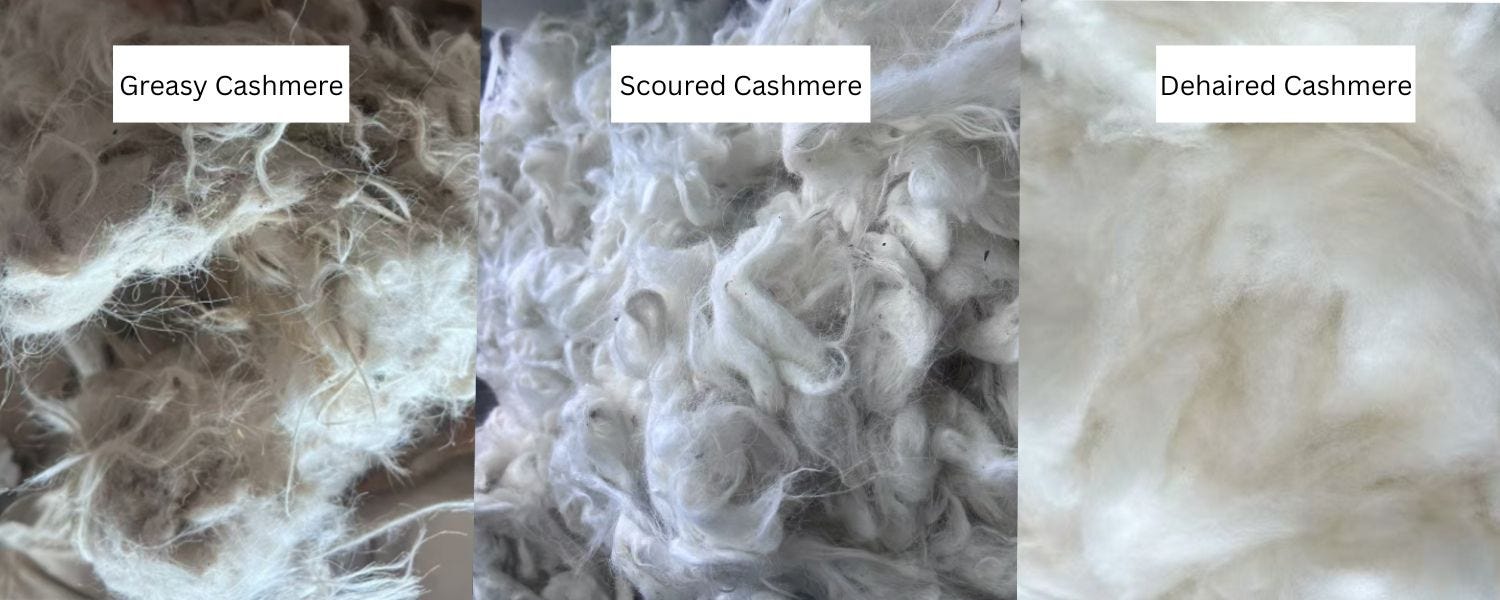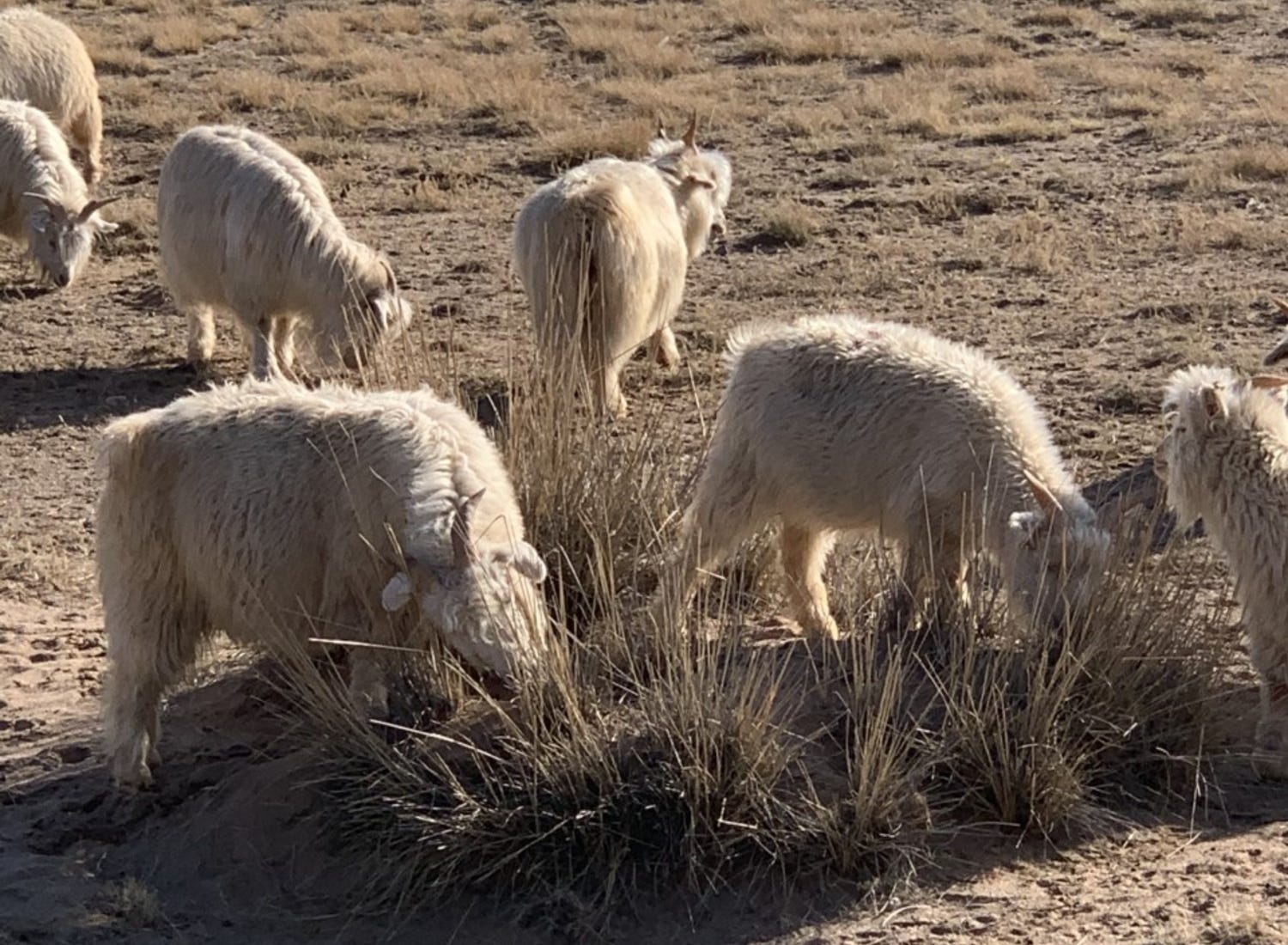Expedited shipping options available
Cashmere FAQ's


What is cashmere?
Cashmere is a hair that comes from a particular type of goat – Capra Hircus Laniger. It is the soft, fine under layer of fiber that keeps the animals warm through the harsh winter conditions of the Asian steppe. The cashmere grown by these goats has incredible insulation properties. Goats also have coarse outer guard hair that is very similar to the hair on our heads. Each spring, cashmere goats are either combed or shorn to remove the soft cashmere. It is mixed with coarse guard hair, dirt and grease. At Alashan, we support a cooperative of herders from Inner Mongolian and procure fine raw fiber that is combed from their white cashmere goats.
Why is Cashmere More Expensive Than Other Fiber?
We understand that cashmere is an investment. There are reasons behind the higher cost of cashmere raw material when compared to other fiber production.
- 1. We first need to look at annual production of cashmere and then compare it to other fibers produced to get a sense of its scarcity. The fiber is grown and harvested in remote areas of the Asian steppe. It is a long route to processing centers and production mills from the grasslands of Mongolia or mountains of Afghanistan. The current estimates for production from the three primary growing countries, in greasy tons, are as follows:
China – 15,000-18,000 tons
Mongolia – 10,000-12,000 tons
Iran & Afghanistan – 1,000-1,200 tons
Total estimated – 26,000 – 31,200 tons
Let us compare this to other annual production figures:
The world’s annual sheep wool production is over 2,000,000 tons.
The world’s annual cotton production is 25,000,000 tons.
The world’s annual synthetic fiber production is over 75,000,000 tons.
The amount of cashmere produced annually is far, far less than wool, cotton and synthetic fiber. This scarce luxury fiber demands a premium based on production numbers alone.
2. We next need to look at the production process of cashmere. Cashmere fiber shorn or combed from a goat is called “greasy” cashmere or “raw” cashmere. At this stage, it needs to be sorted by hand for grade, color and synthetic contamination. After the sorting it must be scoured, or washed, to remove dirt and grease. The greasy cashmere shrinks by upwards of 20-30% in scouring.
Because cashmere goats produce two fleeces, the soft cashmere layer and the coarse outer guard hair layer, the next step after scouring is called dehairing. This is where the guard hair is removed mechanically from the cashmere. This results in a further yield loss.
Good greasy Mongolian or Chinese cashmere can lose 40-50% of its original weight by time it reaches the state of dehaired cashmere and is ready for dying, carding and spinning. Each goat produces about 110-120 grams of dehaired cashmere per animal or about 4-5 ounces. It takes 2-3 goats to produce enough cashmere for just a lightweight sweater.
Assuming a 50% yield from greasy to dehaired, a greasy kg of cashmere that costs $35 will be worth $70 per dehaired kg, plus the cost of the sorting, scouring and dehairing. To this you must add costs for dying and spinning, plus a further yarn spinning yield. Once yarn is produced, it must be knitted or woven into garments or fabrics, coming with further production costs. Those garments then need to be shipped to destination and distributed to retailers or end consumers. At every step of the production process there can be additional transportation costs involved.
When you put this all together, you can begin to see why the luxury of cashmere comes at a premium in pricing over products made from other fiber.


How to make your cashmere last?
-
Clean your sweaters before storing as moths are attracted to natural fibers, especially when soiled.
It is best to fold your garment and store on a shelf or in a drawer.
Do not use a hanger as this pulls and stretches the garment out of shape.
Should natural pilling occur, use a sweater stone or sweater comb.
Gently run the stone along the affected areas in one direction. The pumice material will help lift pills occasionally caused by regular wear, often in areas of high friction.
How do I wash my cashmere?
-
Hand washing or dry cleaning is recommended.
When hand washing, you should use lukewarm water and a mild soap or shampoo. Gently work the suds into the fabric and rinse thoroughly.
When drying the garment, gently squeeze excess water out or lightly roll in a clean towel.
Lay your garment flat in its natural shape to dry completely before storing.
Is Cashmere Warmer Than Wool?
Both cashmere (the hair of a goat) and wool (the fiber from a sheep) are good insulators and will keep you warm. Here at Alashan we offer garments made from both of nature’s best fiber insulators. But side by side, cashmere is a better insulator because it takes less cashmere fiber to keep you warm. In general, cashmere is about 8 times warmer than wool. Cashmere is softer than wool as well, so you get more comfort from a lighter fabric to stay just as warm.
If you have any other questions please feel free to email us at info@alashancashmere.com



